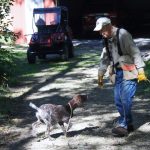Pointing Dog Pointers: The Silent Whoa – Steadying Your Dog
September 2021
By Bob and Jody Iler
Our hot Iowa summer limits the opportunities to get our English Setter Bonnie over to our “farm” for a good workout. There, we have pasture acres for her to run in, a wooded hillside, even a pond to cool off in. She’s not a warm weather dog, so we try to make sure the temps are below 60 degrees, at least, before any extended exercise. Awhile back, we had some rare cool nights and headed with her to the farm one early morning before the sun had a chance to warm things up.
Bonnie is steady to wing and shot – but we wondered how well she’d perform after her summer break. We planted a pigeon a good distance out in some pasture cover. After heeling to the field, she was shaking with excitement as she stood, waiting to be released. She took off like a shot, tail cracking, into the field. About 30 feet from the planted bird, Bonnie wheeled and froze, her tail at 12 o’clock. As she watched, trembling but otherwise motionless, the pigeon was located and flushed. The bird exploded into the air and she followed his path with her eyes but never moved a muscle, even after the shot, until she was released with a tap on her head. The entire scenario was enacted in silence.
This performance, to us, is the “sweet spot” of dog training, the thing that gives us goosebumps and ignites the bird dog fever. There’s nothing quite like the thrill of watching a finished dog in the field – an accomplishment that represents months and years of training and dedication. Our little setter had learned her lessons well and given us a morning to remember.
Should You Steady Your Dog?
Whether to train your pointing dog to be steady to wing or to wing and shot is up to each owner/handler. Many hunters prefer their dogs to chase after the bird when it is flushed and may feel that the dog has a better chance of retrieving the shot bird, especially if it’s crippled. They may not have, or want to invest in the time that it takes to train a dog to be steady to wing and shot and in addition, the work involved in keeping the dog that way.
For those who are interested in field competition, many events require a pointing dog to be steady to wing and shot. Even if you aren’t interested in competition, having a dog that is steady to wing has its advantages. Often this dog has a better chance at marking the bird as it is shot and comes down. Also, if the dog remains steady, this lessens the chance of flushing other birds that might be ahead in the same field. And more importantly, the dog that is steady to wing has a better chance of not being shot by an overeager hunting partner (or even overzealous owner). Steadying to wing can also help to eliminate common problems with the young dog like jumping in on and busting birds, or creeping and moving forward on point.
When (and How) Should You Begin?
Hunt your young dog for at least a season (maybe two if she’s coming along slowly) on multiple birds before beginning this training. A year and a half to two years of age is a good estimate. Make sure your dog first knows and responds well to the heel, here, and whoa commands, and is well-developed to the gun. Especially, you want this young student to be over-the-top enthusiastic about birds and having fun in the field before you start steadying her to wing!
Start out in the yard or driveway, heeling your dog along with a 20-foot checkcord, leaving the excess line trail behind you. As you walk along, stop occasionally, saying nothing – while at the same time using some slight pressure on the training collar attached to the checkcord to make her stand still. If she should try to move or sit, reach down and put your hand in front of her flank to prevent this, still saying nothing. You can also use a half-hitch on the dog as you walk along; when you stop, the half-hitch will keep the dog in the standing position. Some dogs struggle with the half-hitch, so get them accustomed to it before you use it as a training aid. We prefer to use only gentle neck pressure whenever needed.
Once she will stand quietly when you stop without any pressure, step a short distance away, about four feet or so, keeping the dog on the whoa. Facing the dog, give the whoa hand signal. Gently reach into your vest and remove a pigeon, not letting the dog see it as you take it out. Holding the bird by your side, quickly release it. As it flies away, the dog will break and want to chase. Holding the checkcord firmly in hand, place her back where she was and repeat the exercise. After two or three released birds, quit. Remember, NO VOICE! You can skip a day in between exercises. Continue to slowly increase the distance from the dog as you progress, until you can release a bird from 20 feet away, all the while using no voice, just the hand signal. Use your checkcord and slight neck pressure reinforcement if needed.
Once the dog has mastered standing quietly from a good distance away while the bird is released, it’s time to combine the e-collar with the checkcord for reinforcement. Start out with the lowest setting on the e-collar and watch for a slight twitch of the dog’s ear or head, showing her response to the stimulation. Now, when you stop during your heeling and put slight pressure on the dog’s neck with the checkcord, you’ll also add the light stimulation of the e-collar simultaneously. As lessons progress, you’ll eliminate checkcord pressure entirely and use only the e-collar. If the dog starts to break a little as the bird is released, you may need to advance the level of stimulation slightly on the e-collar, but do this sparingly and watch closely for the dog’s reaction. We don’t want this to be negative, just enough to keep the dog steady as the bird is released and flies away.
Head to the Field
Now you are ready to go to the field with your dog for this exercise. Plant just a couple birds in the field – one or two positive performances is enough at each session. Have the checkcord on your dog at first, just as a backup, as well as the e-collar, but use only the e-collar, and use at the level that your dog is responding well to. Use the collar sparingly and only as needed as the bird is flushed. Keep your dog steady as the bird flies, and then release her with a tap on her head. Within a couple weeks or less you should see your dog remaining steady to wing.
Eventually you will introduce the blank gun into the training process. This will be an extension of keeping the dog steady to wing, and now, steady to the shot as well. The gun generally raises the dog’s enthusiasm level, so you may have to use a little e-collar reinforcement, but again, sparingly. Once you have your dog trained to this level of perfection, you must keep her that way – by not ever letting her break to wing or wing and shot again. If you do, you’ll lose much of your training. During the process of teaching your dog to be steady to wing and shot, refrain from retrieves – this can be counterproductive to your training.
During all of this time, you’ve used the silent whoa method. But remember, if you’ve trained your dog using the silent whoa, in a competitive event you still have your voice to use as a reserve command. Since you haven’t been overusing your voice during your dog’s training, you have an advantage, a back-up, that your bracemate may not have!
This “college-level” training puts pressure on a young dog. That’s why we want our dog to be bird-crazy first, hunting with enthusiasm, and handling well in the field and in yard work. We want the dog to be excited by the sound of the gun, not nervous. We want the dog to be happy and excited, and having fun. We want her to be mature enough to handle this training and to be kept steady to wing and shot over time. This training separates the “men from the boys” and the “girls from the women!” It can be extremely challenging to put this much polish on a pointing dog, but the reward will stir your soul.
Pointing Dog Pointers features monthly training tips by Bob and Jody Iler, who operated Green Valley Kennels in Dubuque, Iowa, training pointing dogs for 50 years. Bob and Jody have written many articles for The Pointing Dog Journal.







